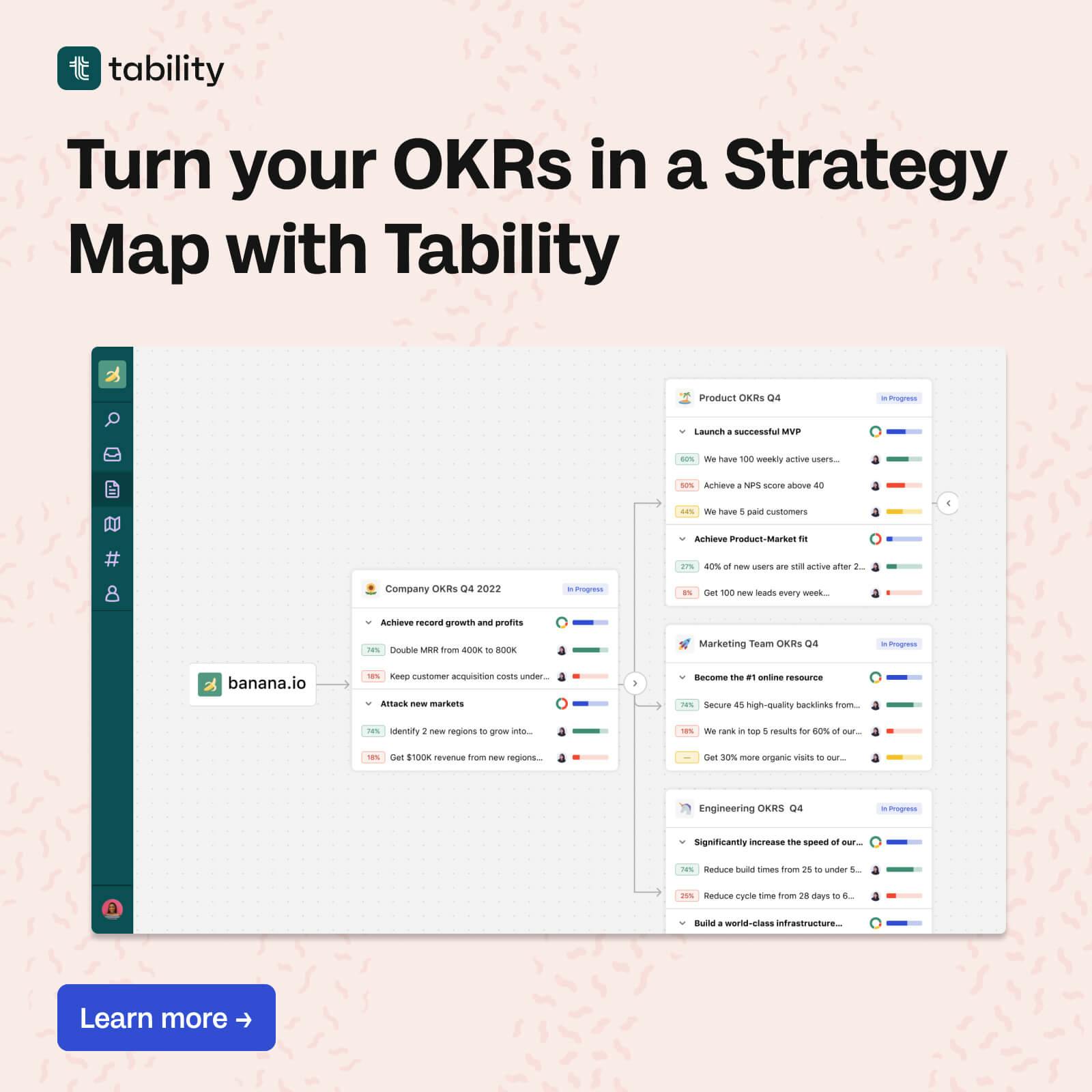2 OKR examples for Design System Efficiency
Crafting effective OKRs can be challenging, particularly for beginners. Emphasizing outcomes rather than projects should be the core of your planning.
We have a collection of OKRs examples for Design System Efficiency to give you some inspiration. You can use any of the templates below as a starting point for your OKRs.
If you want to learn more about the framework, you can read more about the OKR meaning online.
Best practices for OKR
Your objectives should be ambitious, but achievable. Your key results should be measurable and time-bound. It can also be helfpul to list strategic initiatives under your key results, as it'll help you avoid the common mistake of listing projects in your KRs.
Building your own OKRs with AI
While we have some examples below, it's likely that you'll have specific scenarios that aren't covered here. There are 2 options available to you.
- Use our free OKRs generator
- Use Tability, a complete platform to set and track OKRs and initiatives – including a GPT-4 powered goal generator
How to track OKRs
The rules of OKRs are simple. Quarterly OKRs should be tracked weekly, and yearly OKRs should be tracked monthly.
We recommend using a spreadsheet for your first OKRs cycle. You'll need to get familiar with the scoring and tracking first. Then, you can scale your OKRs process by using a proper OKRs-tracking tool for it.
We recommend Tability for an easy way to set and track OKRs with your team.
Check out the 5 best OKR tracking templates to find the best way to monitor progress during the quarter.
Design System Efficiency OKRs templates
You'll find below a list of Objectives and Key Results for Design System Efficiency.
OKRs to improve the effectiveness and efficiency of our design system
Improve the effectiveness and efficiency of our design system
Reduce system-related design errors by 20%
Regularly update system software to minimize glitches
Implement rigorous quality control checks in the design process
Increase training for design team on error prevention
Improve the reuse rate of the system components by 15%
Regularly review component reuse metrics for constant improvement
Analyze current system components usage and identify areas for improvement
Implement reusable software design strategies across the development team
Increase the user interface consistency by 30%
Develop guidelines to improve UI uniformity
Implement changes and assess improvements
Analyze current UI elements for inconsistencies
OKRs to improve efficiency and effectiveness of our CRM system
Improve efficiency and effectiveness of our CRM system
Increase sales productivity by 25% through better CRM system integration with sales processes
Implement necessary upgrades and modifications to CRM system for seamless integration
Analyze current CRM system and identify areas for improvement and integration
Monitor and measure sales productivity regularly to track progress and make further adjustments
Train sales team on effective utilization of CRM system and integrated sales processes
Improve customer satisfaction by achieving a 15% increase in CRM system usability
Regularly monitor user feedback and make incremental adjustments to enhance CRM system usability
Collaborate with UX designers to redesign the user interface based on user feedback
Conduct user research to identify pain points and areas for improving CRM system usability
Implement training sessions to educate employees on how to effectively utilize CRM features
Reduce time spent on data entry by 30% through automation and streamlined processes
Implement data entry automation tools and software
Analyze data entry processes and identify bottlenecks for streamlining
Train employees on efficient data entry techniques and tools
Regularly monitor and evaluate data entry processes for ongoing improvements
Increase user adoption rate of the new CRM system by 20%
Implement regular communication channels to share success stories and benefits of the CRM system
Assign CRM system ambassadors who can provide ongoing support and guidance to users
Provide comprehensive training sessions for all employees on using the new CRM system
Offer incentives and rewards for employees who actively use and promote the CRM system
More OKR templates
We have more templates to help you draft your team goals and OKRs.
OKRs to expand reach through paid advertising with 30% more impressions
OKRs to enhance satisfaction levels of our clients
OKRs to enhance the User Experience (UX) for our digital products
OKRs to build an efficient hiring pipeline
OKRs to increase cost management efficiency for people and operations
OKRs to eradicate procrastination and bolster productivity for superior daily results
OKRs resources
Here are a list of resources to help you adopt the Objectives and Key Results framework.
- To learn: Complete 2024 OKR cheat sheet
- Blog posts: ODT Blog
- Success metrics: KPIs examples
